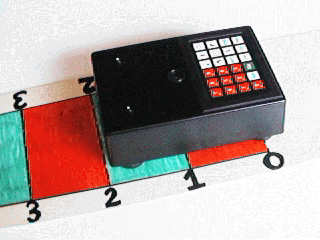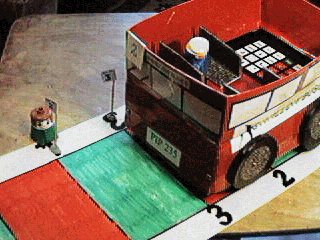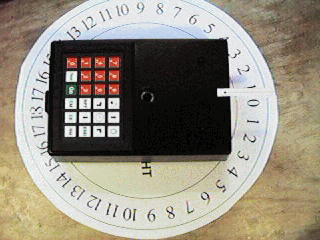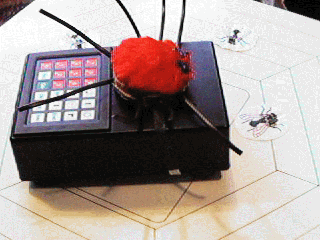|
|

Number lines are the maths teacher's favourite. They use a line of numbers placed at convenient intervals such as 10 centimetres or PIP's length. PIP has its movement units set to match the number spacing.
The numbers go from 0 to as far as you have room. 0 to 12 is best but takes nearly three metres using PIP lengths. An ideal number line would also have negative numbers, perhaps from -12 to 12 with 0 in the middle. This is impractical, so start with positive numbers from 0 to as large as you have room for.
The simplest thing to do with PIP on a number line is to start PIP at 0, enter forwards a number (e.g. 5) and ask the children to tell you what number PIP will end up next to.
One teacher I know gives the children a set of digit cards each and they choose which number they think that PIP will end up next to and put that card, face down, in front of them. This ensures that they can each make a guess without hearing other children's guesses. Digit cards can be made simply with your favourite DTP or word processing package and the resulting print-out stuck onto card.
This exercise is then repeated with different start numbers and different amounts of movement for PIP. Observant teachers will notice listening and talking skills as well as the obvious mathematical knowledge.
You can animate simple arithmetic with PIP on a number line. Forwards 1 followed by forwards 2 will move from 0 to 3 just the same as forwards 3. (1+2=3)
This activity also shows that it doesn't matter in what order you add numbers together; e.g. forwards 1, forwards 2 moves the same amount as forwards 2, forwards 1.
You can "subtract" on the number line using backwards. You can also multiply using repeat sequences.

Our favourite number line activity has PIP dressed as a bus. The terminus is 0. A number 2 bus is programmed with forwards 2. Starting at the terminus, everywhere PIP stops (2,4,6 etc.) is a number 2 bus stop. They can be marked with bus stop posts made out of cocktail sticks with paper flags attached. This is repeated using 3 and 5. This activity reinforces the "2 more", "3 more" etc. sequences.
Some of the questions that need to be answered include:- Why don't buses stop at 7 and 11? How do I go from 3 to 10? What is special about where I change buses?
You should ensure that the cross-curriculum aspects are taken care of. The children should be aware of getting on the correct number bus, never getting on or off the bus without Mum, paying for tickets etc.

Many number line activities can be done in a smaller space on a number circle. For this you set PIP to turn in units of 10 degrees add a pointer to the front and use it on a circle. This is the best way of having large positive and negative numbers in a reasonable space as you can go up to +/-18 on the circle. You will have to establish a convention about which way is "positive".

This is a classic primary use of PIP. It is dressed-up as a spider and used on a stylised web. Draw the web on cardboard or, for permanent use, on white hardboard protected by clear self-adhesive film. The web should be about 1 metre square.
The spider's meal of insects can be pictures stuck on card. The spider can be a drawing stuck onto PIP.
Our spider is made from fake cuddly-toy fur. The legs are electrical cable. The spider is attached with a piece of elastic beneath PIP.
Our insects are clip-art covered in self-adhesive film. They have a small magnet stuck on top (It would be better with just a small piece of steel, e.g. a nail). We have a magnet stuck at the front of the bottom of PIP with Velcro. If you are lucky the fly will be picked up by the magnet underneath PIP as it goes over the top.
The underlying maths of this idea is the use of polar coordinates. When going to the insects it is much easier to turn PIP to point to the target, go to it and then return to the centre before turning to the next target.
The web is a good structure for learning to estimate angles. Make sure that the radiating strands are equally spaced. 6, 8 or 12 strands are good. You may like to make PIP's turn and movement units match the sizes of the angles between the strands and the distance between the "circles".
Our web has 6 radial strands giving an angle between them of 60o. The "circles" are 5 centimetres apart.


